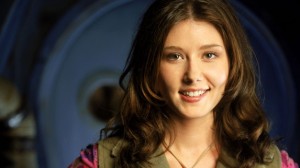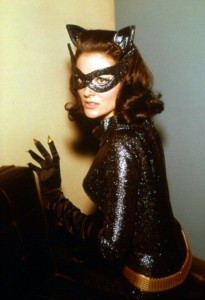 7. Mikaela Banes – Not much effort was expended in fleshing out Megan Fox’s character in the first two Transformers movies. The robots were there for the fans, the Sam Witwicky character was there as the manquÁ© for the audience, and Mikaela…leaned over stuff farther than she actually needed to. Not that it made much of a difference. For the brief time Fox was a part of the franchise, she was a rising, inescapable star. When she and director Michael Bay had a parting of the ways, it seemed the arc of her rise had bottomed out too.
7. Mikaela Banes – Not much effort was expended in fleshing out Megan Fox’s character in the first two Transformers movies. The robots were there for the fans, the Sam Witwicky character was there as the manquÁ© for the audience, and Mikaela…leaned over stuff farther than she actually needed to. Not that it made much of a difference. For the brief time Fox was a part of the franchise, she was a rising, inescapable star. When she and director Michael Bay had a parting of the ways, it seemed the arc of her rise had bottomed out too.
6. Kaylee Frye – Joss Whedon populated the crew of the Serenity with several interesting characters, each with a standard stereotypical personality trait that got tweaked a little, except for one. Of the women on the ship you had the tough-as-nails Second in Command who was also very married; the courtesan who is also somewhat a dignitary rather than the standard “hooker with a heart of gold” type; the hope for the universe who also happens to be deeply damaged, perhaps even autistic, and highly unstable…and you have Kaylee. She is the girl next door who flies off into space but remains, nonetheless, the girl next door.
 So why do all the other characters, male and female, get complications and backstory flips and Kaylee just gets Kaylee? I suspect that is because she is part of the grand tradition of genre characters designed to be gateway figures. They are the most normal by audience standards and, therefore, can carry the weight of expository information. As they describe the weirdness to a stranger on screen they are, in that process, explaining it to you. They are very useful, often necessary, and generally boring.
So why do all the other characters, male and female, get complications and backstory flips and Kaylee just gets Kaylee? I suspect that is because she is part of the grand tradition of genre characters designed to be gateway figures. They are the most normal by audience standards and, therefore, can carry the weight of expository information. As they describe the weirdness to a stranger on screen they are, in that process, explaining it to you. They are very useful, often necessary, and generally boring.
So by using the sweet, attractive Kaylee, as played by Jewel Staite, Whedon and company engage in a conversation aimed at the show’s watcher and that, as you can imagine, is catnip to nerdist tendencies. Zoe might boss you around; Inara is just doing her job; and River might just kill you, either on purpose or accidentally, but Kaylee says what she means and is guileless. She is Whedon’s reliable narrator, and immediately becomes the focal point candidate for your TV crush. As for the name, well, I’ll take a wild guess. Whedon’s production company was called Mutant Enemy, from the Yes song “And You And I” (“There be no mutant enemy we shall certify — political end, our sad remains will die…”) I’m going to say that Kaylee’s namesake was “Kayleigh,” the first significant single in the U.S. from another prog rock band, Marillion. Only a true nerd would know for sure though.
 5. Any Catwoman from the ’60s-era TV show – Catwoman is everything that an introvert could ever want. She’s a bad girl (a thief, actually). She’s an initiator and no shrinking violet. She wears a bodysuit that has been either vinyl or leather, but either way she exhibits a veneer of kink that appeals to a certain subset of the audience. So powerful an image was Catwoman to Batman’s audience that Marvel had to have a version for their human/animal superhero (being The Black Cat to Spiderman). So you can imagine what psychic distress the Batman television show of the ’60s caused for an impressionable viewership. Catwoman wasn’t just a symbol for the burgeoning sexual revolution. She became an icon of it’s darker side.
5. Any Catwoman from the ’60s-era TV show – Catwoman is everything that an introvert could ever want. She’s a bad girl (a thief, actually). She’s an initiator and no shrinking violet. She wears a bodysuit that has been either vinyl or leather, but either way she exhibits a veneer of kink that appeals to a certain subset of the audience. So powerful an image was Catwoman to Batman’s audience that Marvel had to have a version for their human/animal superhero (being The Black Cat to Spiderman). So you can imagine what psychic distress the Batman television show of the ’60s caused for an impressionable viewership. Catwoman wasn’t just a symbol for the burgeoning sexual revolution. She became an icon of it’s darker side.
There were three actors who played the role on the show – Julie Newmar, Lee Meriwether, and Eartha Kitt. Back then you didn’t need to explain why a character looked different each time he or she reappeared in a show. Soap operas were riddled sick with such sudden cast change-ups. But the things that remained about the Catwomen were the seamier aspects of her persona that “turned on” a generation of superhero enthusiasts. The character has, since then, been played by a string of attractive actors, from Michelle Pfeiffer to Halle Berry to Anne Hathaway most recently, but there remains this inextricable link for viewers to those original Catwomen that the newest bunch cannot hope to attain.
And that all comes down to the fact that, in their mostly innocent way, they were lightly tweaking taboos on national TV in a kids show no less. Not even Lynda Carter’s Wonder Woman in the gold-eagle bustier had that much of a foot in the dark waters of such attitudes. For the first time on a major television production, watchers got the bad girl who was bad all the way and took what she wanted…and they liked it.
Who’s my pick for top Catwoman? Probably Lee Meriwether because it was so weird to see here all suited up, then turn the channel and find her being patronized by Barnaby Jones.





Comments